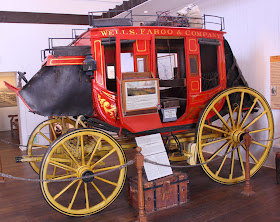Example of a mud coach from the Wells Fargo History Museum in San Diego.
The role of travel was slow five to seven miles per hour, however over a day, they might cover sixty to seventy miles. Breaks occurred at places called swing stations or home stations. Stages began running regular routes in 1744, between the budding metropolis of New York and Philadelphia. The distance took three days to cover until the year 1766 when a new more trustworthy coach was implemented. These coaches carried not only letters, but packages, merchandise, and in some cases - money. By 1832, Boston alone had over 77 lines.
While these vehicles were great in moving the masses, they were not comfortable. Iron and steel springs did not allow the body of the coach to compensate for the pot holes by moving side to side. They instead bounced up and down jostling the passengers and often tossing them against their co riders. In 1829, a major innovation came through the use of leather straps that allowed the body to be somewhat suspended and move not only up and down, but also side to side. In Twain's book, Ruffing It, he described his travels by stage as "riding a cradle on wheels".
Space meant money. People were often crammed inside on three hard seats. If riding in the middle they held on to straps suspended from the ceiling to keep from pitching back or forward. Others decided it was safer to be perched on top of the stage. If you think about it, you can understand why. Imagine, if you will, nine passengers, layered with dust, boots covered with animal waste, perhaps bodies and/or clothing unwashed for months - yeah, it's a good thing Hollywood made it glamorous.
So how much did this 'luxury' travel cost. Remember, no coke and peanuts. Nope. Meals were extra and cost $1.00 for each meal consumed. Our passengers could chose their travel. First class, cost $7.00 and they rode for the whole trip. Second class passengers were required to walk when the road was bad. And those economy seats in third class, they not only had to walk, but if the coach was going up hill, they were required to push. Something to write home about for sure.
Most stage routes followed the Pony Express examples. Stages stopped in intervals of twelve and fifty miles at two types of stations, a swing station or a home station. Home stations would be at the fifty mile route marker. These would be run by families and served hot meals and allowing their 'guests' to sleep over night on the hard floors. Home stations would also be where drivers changes occurred. A swing station came at the twelve mile markers and would be run by bachelor stock men. Their accommodations would be a cabin or barnc. The stage would stay long enough to change teams and allow passengers to stretch their legs. From Kansas to California there were one hundred and fifty of these type stations.
All good things do come to an end. Railroads pushed the stage lines from the most prominent towns. Routes they followed, now took them to towns the trains didn't service. However, the death blow to the stage lines came with the invention of the automobile in the early 1900's.
Famous stage lines were:
Buutterfield's Overland Mail Company
Wells Fargo and Company
Holladay Overland Mail and Express Company.
The more iconic stage. Again from the Wells Fargo History Museum in San Diego.
Until next time,
Happy Trails
Nan O'Berry




No comments:
Post a Comment
Our readers: If you like a post, please consider sharing on your Facebook and/or Twitter pages, and leave a comment. The cowgirls welcome them and will respond if you ask questions. Any Spam will be deleted.